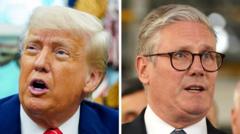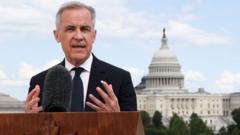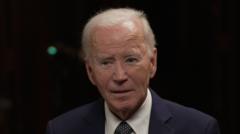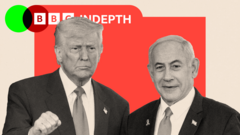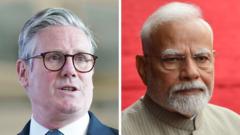The trade war between the US and China intensifies as both nations express a willingness to negotiate tariffs, but neither is ready to make the first move. Recent statements highlight the need for face-saving measures, underscoring the complexities of finding common ground in the ongoing conflict.
High Stakes and High Tariffs: The US-China Trade Negotiation Dilemma
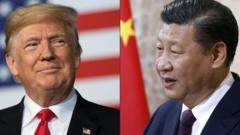
High Stakes and High Tariffs: The US-China Trade Negotiation Dilemma
As both nations seek to avoid appearing weak, the possibility of de-escalation remains uncertain amid conflicting signals in the ongoing trade war.
On Friday, Chinese commerce officials revealed that Beijing is contemplating tariff negotiations with the United States, a development that the global community eagerly watched for. With tariffs climbing to an astonishing 245% on certain Chinese goods, trade is significantly hindered between these economic giants, triggering recessionary fears. "US officials have voiced a readiness to negotiate on tariffs consistently," the spokesperson noted. "China's stance remains unwavering. If we engage in conflict, we will persist; if discussion is on the table, we remain receptive... The US must demonstrate sincerity and rectify its wrongful practices, including canceling unilateral tariffs."
This announcement follows a report from a Beijing-linked Weibo account suggesting Washington was keen to discuss matters, and Trump's earlier suggestion that talks were already in progress was contested by China. The Weibo account, affiliated with China Central Television (CCTV), stated, "China is under no obligation to engage with the United States." It further implied that America is more desperate for negotiations at this stage.
Trailing this exchange, experts label the situation a "game of chicken" between Trump and Xi, each attempting to maintain dignity while covertly seeking a favorable resolution—specifically, a de-escalation of the trade conflict. "This back-and-forth is expected, as neither side wishes to appear to concede," stated Ja Ian Chong, a political science assistant professor at the National University of Singapore. Wen-Ti Sung, another academic, elaborated, "It's akin to high-speed racing: whoever veers first may be seen as weaker."
In this peculiar stalemate where both sides desire the same outcome but refuse to make the first move, a tactic labeled "constructive ambiguity" is being employed. This strategic vagueness allows each party to claim the moral high ground at the negotiation table. Experts suggest this could indicate Beijing's intent to softly navigate the dialogue towards an exit strategy.
A potential resolution could involve a third-party mediator or a broader interpretation of communication that allows either side to claim the initiative without appearing to capitulate. For both leaders, optics are essential; they must deliver perceived victories to their domestic audiences amid mounting economic pressures.
With both Trump and Xi confronting tariff-induced hurdles, their domestic priorities are colliding with international relations. Trump is grappling with concerns about a recession, while Xi must convince his populace that his leadership can withstand the trade turmoil, all while recovering from the lingering effects of the pandemic.
"Both leaders realize that the outcome of this trade dispute cannot be zero-sum for either side," Sung noted. "Trump understands that he won't gain everything he desires, thus he seeks a compromise that can appear victorious on the home front."
For Xi, balancing the negotiation with maintaining face for China's rising narrative is critical. "Concessions paving the way for negotiations may bolster his standing domestically," Sung added.
Currently, while the US has not contested China's claims of seeking talks, signs of possible communication could signify a willingness to accommodate. However, analysts caution that negotiation beginnings do not guarantee stability in US-China relations, which have been fraught with tension even prior to the trade war’s inception.
"I wouldn’t hold my breath just yet," Chong remarked, interpreting current posturing as indicative of underlying hesitance toward forging an exit strategy. The question of which nation will yield first still looms over the landscape of international economics.






